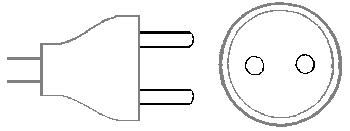 Question 04/03
Question 04/03
ELECTRIC OUTLET

Electric outlet has two "current carrying holes", one of which is the
"phase" while the other one is "zero". (In addition, many outlets have a third hole
for the "ground".) After many years of usage with high-power devices (ovens, heaters, etc.)
one may notice that the "phase" side of the outlet shows some signs of overheating.
Sometimes (especially in low quality outlets or plugs, and in the cases when the plugs
are repeatedly inserted/removed from the outlets) burning signs can be detected
on the plug or the outlet. (These are more frequent in 220/230 Volt outlets.) Obviously,
the same current is flowing through both holes of the outlet. Why do
these signs appear on the "phase" hole/pin more frequently than on the "zero" side?
 Back to "front page"
Back to "front page"
 Question 04/03
Question 04/03 Question 04/03
Question 04/03
 Back to "front page"
Back to "front page"